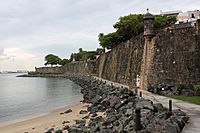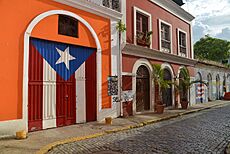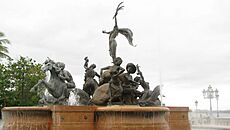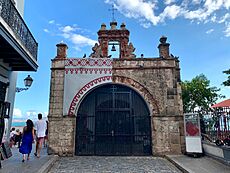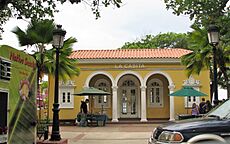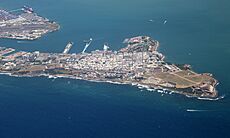Old San Juan facts for kids
Quick facts for kids
Old San Juan
Viejo San Juan
|
|||||||||||||||||||||||||||||
|---|---|---|---|---|---|---|---|---|---|---|---|---|---|---|---|---|---|---|---|---|---|---|---|---|---|---|---|---|---|
|
Historic district
|
|||||||||||||||||||||||||||||
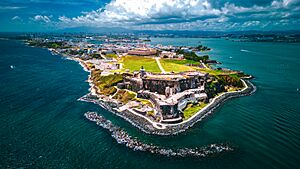
Aerial view of Castillo San Felipe del Morro and Old San Juan
|
|||||||||||||||||||||||||||||
| Nickname(s):
La Ciudad Amurallada (The Walled City)
|
|||||||||||||||||||||||||||||
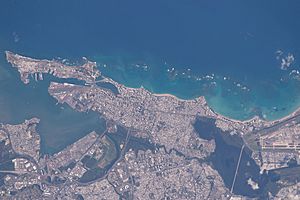
Satellite image of Old San Juan within San Juan Antiguo alongside Santurce
|
|||||||||||||||||||||||||||||
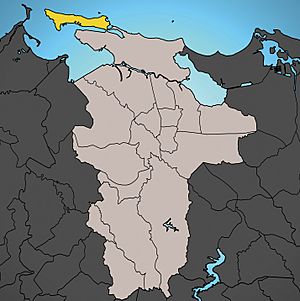
Location of Old San Juan within San Juan Antiguo shown in yellow and San Juan shown in light grey
|
|||||||||||||||||||||||||||||
| Commonwealth | |||||||||||||||||||||||||||||
| Municipality | San Juan | ||||||||||||||||||||||||||||
| Established | 1521 | ||||||||||||||||||||||||||||
| Time zone | UTC-4 (AST (no daylight saving time)) | ||||||||||||||||||||||||||||
| ZIP codes |
00901-02
|
||||||||||||||||||||||||||||
| Area code | 787, 939 | ||||||||||||||||||||||||||||
| Subbarrios (sub-wards) | Ballajá, Catedral, Marina, Mercado, Puerta de Tierra, San Cristóbal, San Francisco | ||||||||||||||||||||||||||||
| Website | |||||||||||||||||||||||||||||
| Official name: La Fortaleza and San Juan National Historic Site in Puerto Rico | |||||||||||||||||||||||||||||
| Type: | Cultural | ||||||||||||||||||||||||||||
| Criteria: | vi | ||||||||||||||||||||||||||||
| Designated: | 1983 (7th session) | ||||||||||||||||||||||||||||
| Reference #: | 266 | ||||||||||||||||||||||||||||
| Region: | The Americas | ||||||||||||||||||||||||||||
|
|||||||||||||||||||||||||||||
Old San Juan (Spanish: Viejo San Juan) is a special historic area in San Juan, Puerto Rico. It's located on a small island called the Isleta de San Juan. This area is made up of several smaller neighborhoods, like Ballajá and Catedral.
Old San Juan is the oldest settlement in Puerto Rico. It's a historic colonial district from when Spain ruled the Americas. Many of its old buildings, like La Fortaleza, the city walls, and the El Morro and San Cristóbal castles, are part of a UNESCO World Heritage Site. This means they are very important historical places recognized worldwide.
Contents
Exploring Old San Juan's Location
Old San Juan is on a small, narrow island. This island is on the north coast of Puerto Rico. Three bridges connect it to the main island. The Atlantic Ocean is to the north, and San Juan Bay is to the south.
At the west end of the island, there's a high cliff. On this cliff stands Fort San Felipe del Morro. This fort guards the entrance to the harbor.
The city is famous for its narrow streets. These streets are made of blue cobblestone. The buildings are made of brick and stone with flat roofs. They date back to the 1500s and 1600s.
A Look into Old San Juan's History
How Old San Juan Began
In 1508, Juan Ponce de León started the first settlement. It was called Caparra. But in 1509, the people moved the settlement. They moved it to a place they called "Puerto Rico," meaning "rich port."
In 1521, the name "San Juan" was added. The new settlement was officially named "San Juan Bautista de Puerto Rico." This name honored John the Baptist.
Growing the City
The Casa Blanca was built in 1521. It was the first fort and home for Juan Ponce de León's family. It served this purpose until the mid-1700s.
For a long time, the area outside the city walls was mostly empty. In 1838, the area called Puerta de Tierra had only 168 people. Most of them were of African descent. By 1846, the population grew to 223 people.
In 1865, the city decided to expand. They planned to tear down the city walls on the east side. The demolition officially started in 1897. By 1899, Puerta de Tierra had 5,453 people. The old walled city had about 18,103 people.
Keeping Old Buildings Special
In the late 1940s, many old buildings were falling apart. Some people wanted to build modern buildings. But an expert named Ricardo Alegría strongly disagreed. He wanted to save the old colonial buildings.
He helped change local laws. These new laws encouraged people to fix up old buildings. They also made sure new buildings matched the Spanish colonial style. This helped keep the city's unique look. It also made San Juan a popular place for tourists.
Later, when Luis Muñoz Marín became governor, more efforts were made. The Institute of Puerto Rican Culture was started. It helped make big changes possible. The government offered special loans and tax breaks. This encouraged people to remodel and open businesses.
Strict rules were put in place for remodeling. This stopped new buildings from ruining the old Spanish style. For example, when someone wanted to tear down an old convent to build a hotel, the Institute stopped them. Instead, the convent was turned into the beautiful Hotel El Convento.
These efforts to save and renew Old San Juan have inspired other cities. Cities like Havana, Lima, and Cartagena de Indias have followed its example.
Special Historic Recognitions
The San Juan National Historic Site was created in 1949. It protects the historic forts in Old San Juan. In 1983, this site and La Fortaleza were named a single World Heritage Site by UNESCO. This means they are very important to the world's history and culture.
In 1972, the area within the old city walls was recognized as the San Juan Historic Zone. In 2013, it was named a National Historic Landmark District. This is a very high honor for historic places in the United States.
Cool Places to Visit in Old San Juan
Forts, Palaces, and Walls
- San Cristóbal Castle (Castillo San Cristóbal): This is the biggest fort the Spanish built in the Americas. It protected the city from attacks by land and sea.
- San Felipe del Morro Castle (Castillo San Felipe del Morro, or El Morro): A 16th-century fort at the edge of the island. It also protected against attacks. It has a historic lighthouse.
- Santa Catalina Palace (La Fortaleza): This used to be a fort. Now, it's the official home of Puerto Rico's governor. It's the oldest governor's residence in the Western Hemisphere.
- The San Juan City Walls: These huge walls surround Old San Juan. They give the city its nickname, "La ciudad amurallada" (the walled city). Most of the walls are still standing. Only one city gate remains. San Juan is the only U.S. city that still has its colonial defensive wall system.
Fun Plazas and Squares
- Paseo de La Princesa: A famous walkway along the southern city wall. It offers great views of the walls and San Juan Bay. It's a lively place for festivals. At its end, a boardwalk leads to Puerta de San Juan, the only remaining city gate.
- Plaza Colón: This square is named after Christopher Columbus. It's a popular meeting spot. It's near San Cristóbal Castle and the Tapia Theater.
- Plaza de Armas: This is San Juan's main town square. Important buildings like the historic San Juan City Hall are here. These squares were originally for military parades.
- Plaza de San José: Located near San José Church. It's a popular spot for nightlife. The statue of Ponce de León in the middle is special. It was made from melted British cannons after a failed attack on San Juan.
- Plazuela de la Rogativa: A small plaza with a bronze sculpture. The sculpture shows "La Rogativa" (the pleading). This legend says a procession of women and a bishop tricked British invaders into thinking Spanish reinforcements had arrived.
- Parque de las Palomas (Park of the Pigeons): This is a plaza, not a park. It's at the end of Calle del Cristo. It offers amazing views. Kids especially love it because of the many pigeons there. You can even buy food to feed them!
Churches and Religious Buildings
- San Juan Cathedral: This is the Catholic cathedral. It's one of the oldest buildings in Old San Juan. It's considered the oldest cathedral in the United States. It holds the tomb of Juan Ponce de León.
- San José Church (Iglesia de San José): One of the most important old buildings. It's a great example of 16th-century Spanish Gothic architecture. It reopened in 2021 after many years of renovation.
- Santo Cristo de la Salud Chapel (Capilla del Santo Cristo de la Salud): A small 18th-century chapel. It was saved from being torn down. It's now a famous landmark and cultural symbol of Puerto Rico. It also has a small museum.
Museums to Explore
- Casa Blanca: A house museum in an old fort. It was the home of Juan Ponce de León and his family.
- The Ballajá Barracks (Cuartel de Ballajá): These used to be military barracks. Now they house several important museums, like the Museum of the Americas. They also have a library and schools for music and dance.
- The Puerto Rico National Gallery: This museum has one of the largest collections of Puerto Rican paintings. It's in an old monastery.
- The Casa del Libro Museum: A library and museum about the history of books. It has historic books and documents from the 1400s.
- The Museum of San Juan (Museo de San Juan): Located in the old city marketplace. It shows the history of San Juan and Puerto Rico through art and objects.
- The Felisa Rincón de Gautier House Museum: A museum about Felisa Rincón de Gautier. She was the first female mayor of San Juan. She was also the first female mayor of any capital city in the Americas!
- The Pablo Casals Museum: This museum is in the former home of the famous composer and cellist Pablo Casals. It has his piano and musical instruments.
Other Interesting Spots
- La Perla (The Pearl): This used to be a small, informal settlement. It was first settled by freed slaves in the 1700s. Now, it's a neighborhood known for its culture. It has appeared in movies and music videos, like "Despacito."
- Hotel El Convento: A small hotel in a historic convent. It's known for its beautiful architecture.
- Santa María Magdalena de Pazzis Cemetery: An old cemetery next to La Perla and El Morro. Many important figures from Puerto Rico's history are buried here.
- Tapia Theater: The oldest theater in San Juan. It's one of the oldest in the Caribbean. It's located on Plaza Colón.
- The Old Casino (Antiguo Casino de Puerto Rico): This used to be a casino. Now, it's a place for cultural events and weddings.
Old San Juan Today
Old San Juan is a major tourist spot. It has many shops, historic places, museums, and outdoor cafés. You'll find colorful homes, tree-shaded plazas, and unique architecture.
The district has many public squares. These squares are full of local shops. They sell traditional crafts, sculptures, and musical instruments. Old San Juan is also known for its historic churches. These include San José Church and the Cathedral of San Juan Bautista. The Cathedral holds the tomb of Juan Ponce de León.
Many tourists visit Castillo San Felipe del Morro. This fort was built by the Spanish. Besides the fort, people are drawn to La Perla. This is a colorful neighborhood just outside the old city wall.
Old San Juan is one of the two main areas of San Juan. The other is Santurce.
Parts of Old San Juan
The oldest parts of Old San Juan are still partly surrounded by huge walls. Several forts and defensive buildings helped protect the settlement. These include Fort San Felipe del Morro, Castle of San Cristóbal, and el Palacio de Santa Catalina (also known as La Fortaleza). Many of these historic forts are part of the San Juan National Historic Site.
Old San Juan's land area includes several smaller neighborhoods. These are Ballajá, Catedral, Marina, Mercado, San Cristóbal, and San Francisco.
Getting Around Old San Juan
Old San Juan is a transportation center for the San Juan area. In the past, there was a free trolley system. Now, people usually walk or drive around the city. There have been talks about making the historic district a pedestrian-only zone. There are also plans to rebuild the trolley system or build a new light-rail train system.
See also
 In Spanish: Viejo San Juan (Puerto Rico) para niños
In Spanish: Viejo San Juan (Puerto Rico) para niños




